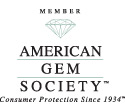What is the True Padparadscha? Again!
September 16th, 2009 by James L. Sweaney, CGA, FGA. GG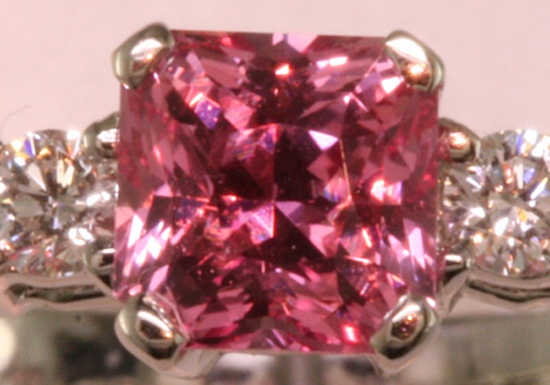
.86 ct Ceylon Padparadscha, Gem, no heat
We published this article February 2009 with good response. Since Sapphire is the stone for September, we thought it appropriate to republish, with minor additions, editing, new pricing information and larger pictures.
Early in my career as a gemologist, while working the gem identification counter at the GIA Gem Trade Laboratory in Santa Monica, I fell in love with Padparadscha—a gemstone, not a girl. The privilege of seeing and handling a few magnificent specimens of this magical sapphire with the glorious sunset orange and pink color was like cupid’s arrow to the heart.
Since that time, I always seek out the dealers at the gem shows who’ve “got the goods” and have had the pleasure to own and sell a number of fine Padparadscha Sapphires. We recently sold this small but extremely fine example, a .86 ct. octagonal loupe clean Sri Lankan stone, perfect color and beautifully cut, certificates from GRS and AGTA showing no evidence of heat treatment.
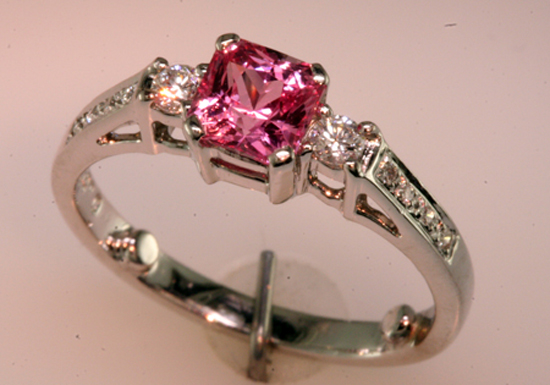
A definition of the true color of Padparadscha can be the heated subject of discussion between gem aficionados and gemologists. The answer is that there is no one Padparadscha color—It’s a range of color that combines pink with orange with no secondary hues or overtones of brown. Even though it’s not a hue described in the GIA Color Description System, pink is almost always used to describe the color, rather than tones of red, even in the GIA literature.
The issue of what should properly be called Padparadscha was addressed by the famous Robert Crowningshield, gemologist extraordinaire, in “Padparadscha: What’s In a Name?” Spring, 1983, Gems & Gemology, pages 30-36. He concluded, “It is GIA’s opinion that this color range should be limited to light to medium tones of pinkish orange to orange-pink hues. Lacking delicacy, the dark brownish orange or even medium brownish orange tones of corundum from East Africa would not qualify under this definition. Deep orangy red sapphires, likewise, would not qualify as fitting the term Padparadscha’.” Note his use of the word “delicacy”— Padparadscha colors are commonly described as delicate, evoking the soft colors of dawn and sundown.
At the time of his article, perhaps due to issues about the goods from Africa and some of the new synthetics, Crowningshield did everything he could to describe “Padparadscha” like the classic Sri Lankan material, but called the term “too subjective” to use on GIA identification reports.
Today’s more modern usage at GIA and other labs such as GRS, AGTA, etc., is to use the term “Padparadscha Sapphire” as a variety name to describe natural sapphires that fall within the typical color range, with no brown. This designation adds significant value to this rare and exotic gem.
These lab reports may also include important information about origin and/or heating. True Padparadscha Sapphires may indeed be heat treated — within the gem trade, thermal enhancement is a normal and accepted practice, so long as the treatment is provable and/or disclosed. Those stones with no evidence of heating are more rare and valuable, bringing substantial premiums over heated gems.
This 18K brooch (with self-mined Deer Creek Fire Agate) by yours truly contains a suite of Sri Lankan Padparadscha sapphires that demonstrates the range of color most gem dealers and aficionados would accept as Padparadscha. Note the gradations from orange with pink to pink with orange, no brown.
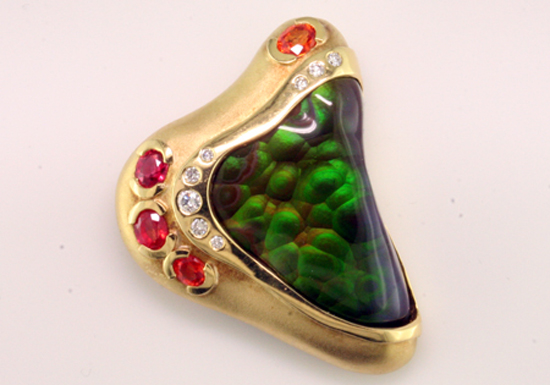
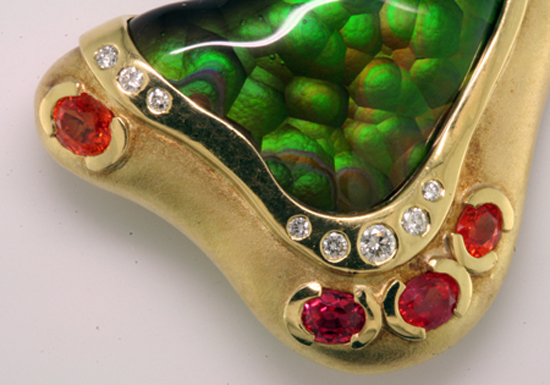
Occasionally, “Pad” colors rise to a strong or even vivid level—this wonderful 4 3/4 carat stone from a Mardon custom ring is one of the more enchanting Padparadschas we have seen.
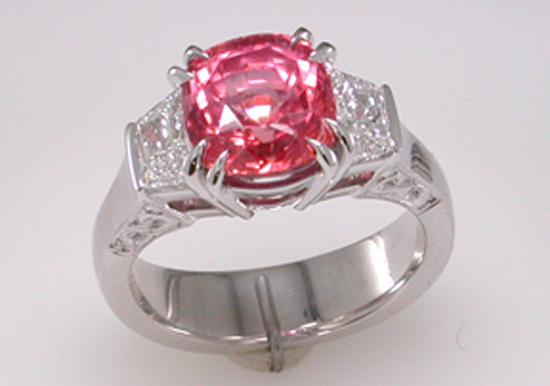

Note the different appearance in the two photos—you wouldn’t think it’s the same stone—but it’s the same stone, same camera, same photo-stage and lights, different lens, different day, minimal editing in Photoshop. For this stone, the orange hue dominates. Photographing gems can be a real challenge!
In some ways, we can more easily say what “Pad” is not rather than what it is.
Origin helps define Padparadscha. The classic locale originally known to produce the finest examples of “Pad” is Sri Lanka (formerly Ceylon), where crystals are found that are basically pink with an orange center. Because of the presence of chromium with no iron, these “Pads” often exhibit reddish fluorescence under UV radiation.
Sri Lankan Padparadscha Sapphires generally have a moderately strong level of saturation, lending the “delicate” colors a richness and impact for which they are famous. As noted, some rise to strong and rarely, vivid levels. Tone is generally medium light, though some will grade light or medium. Hue will span the range (as shown in the brooch), from orange with pink to pink with orange, with no brown tones whatsoever. Its’ been my experience that some of these Sri Lankan stones are more intense and orangy in incandescent lighting, perhaps due to fluorescence, similar to what you sometimes see with Burma rubies.
These Sri Lankan stones may or may not be thermally enhanced– generally, heating of this material seems to be done at relatively low temperature, and in some cases, is difficult to detect. In our experience, stones known to have been heated have been documented by notable gem labs as “no evidence of heat treatment.”
About 1 in 100 pink sapphires from Madagascar, virtually all of which are heated, will change to a true “Pad” color, doubling to quadrupling its value. (Personal communication, Kevin Patterson)
The slightly brownish stones from Africa, particularly those from Tanzania and the Umba River source, were marketed in the 80’s as “African Padparadscha”, but the gem trade and consumers as a whole didn’t really accept the practice or the name. While some examples were attractive, that material never achieved the “brand recognition” and price of the stones from Ceylon. See Crowningshield, p. 32
A few more recent African stones from the Tunduru district, near Olduvai Gorge, are more similar in appearance to the Sri Lankan material, but these can take on a brownish overtone in incandescent light.
Orange sapphires are produced from southern India, from crystals that have a green “rind”. These stones are small and bright orange without the pink hue (personal communication, Kevin Patterson). I suspect this gorgeous very hot stone, vivid orange with no pink, sold from our collection, was from that locale.
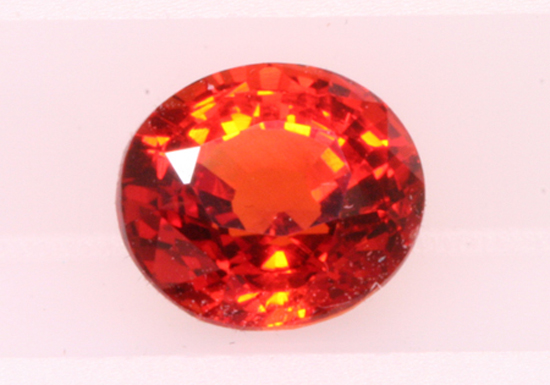
A significant development in the story of Padparadscha occurred within the last decade when relatively large numbers of beautiful pinkish orange stones suddenly showed up in the Asian gem markets. Good science soon prevailed and proved these to be heated beryllium diffused yellow sapphires. Those who were selling this material didn’t disclose the treatment at first and tried to pawn them off as a new find.
Beryllium-diffused orange sapphires are not considered Padparadscha Sapphires, even though they may approach the color of the natural stones. Beryllium diffusion adds something to the natural matrix of the sapphire crystal, creating a pink centered yellow stone, the opposite of the classic Ceylon material. Gemologists can often detect these stones by immersing in methyl iodide and looking for the telltale yellow edge. (Be advised to use care and skill when working with methyl iodide!) Today, these goods are discounted ~ 70% and more at the wholesale level
And of course, synthetic sapphires, while they are truly sapphires of a similar color, are excluded within the gem trade as true Padparadscha—the term is always reserved for natural stones, mined from mother Earth. “Synthetic” or “Created” or “Brand Name” (Chatham, Inamori, etc.) should always accompany the description of such stones. Pinkish orange synthetic flux grown sapphires as well as Verneuil type synthetics are plentiful and can be very difficult to detect, especially the Verneuil stones.
Prices for fine Padparadscha Sapphires can retail from $600-2000 per carat for stones 1 to 2 carats graded good, $2,000-4,000 per carat for fine stones, with extra fine stones going for twice as much. 3 to 5 carat stones, great for rings, start around $1600 for good and range from $6,000 to 20,000 per carat and more for fine to extra fine stones. To quote the GemGuide, “Due to rarity, padparadscha sapphires are highly subjective and may have a large price variance above or belowGemGuide prices.”
Daughter Jenny brought a very interesting article in Town and Country about Padparadscha to my attention. The November 2008 had a great page of Cartier jewelry, all set with Padparadscha Sapphires. Priced from $375,000 to $2,000,000 — After all, it is Town and Country, and it is Cartier! See page 133.
Finally, on the theory that the best way to know the true color of a Padparadscha is to train your eye by looking at good stones, I’ve included more photographs of Padparadschas I have known. I’d like to also invite you to visit Mardon in person—we‘d be happy to show you the real deal and answer any questions you might have about this wonderful gift of nature!
Ask about our Gem Brokering service if you’re in the market for Padparadscha– it’s our specialty! We know where to find the best stones and we know how to obtain proper documentation for these rare beauties. With a simple brokers fee, you’ll pay substantially less than a normal retail price.
Tags: beryllium diffusion, Ceylon, Chatham, GRS, Madagascar, Padparadscha, Robert Crowningshield, Sri Lanka, Tunduru



